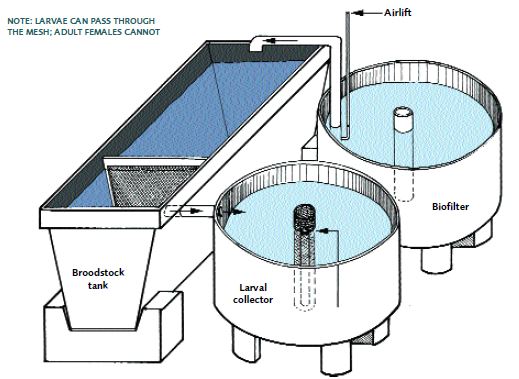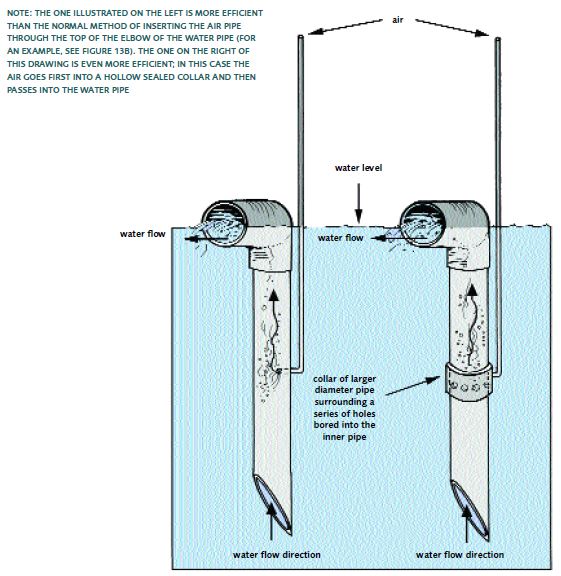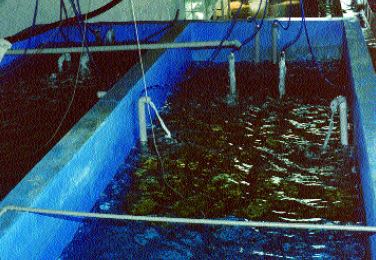3.3 Managing your broodstock
Managing broodstock in outdoor facilities in the tropics is similar to managing grow-out facilities. However, in temperate climates where broodstock are over-wintered, special care is necessary to ensure good health and maintain maximum survival. Broodstock should be disinfected upon arrival at the hatchery by placing them into freshwater containing 0.2 to 0.5 ppm of copper sulphate or 15 to 20 ppm of formalin for 30 minutes.
However, it should be remembered that the use of these chemicals in aquaculture is prohibited or controlled in some countries. Aeration should be provided during these treatments. Similar precautions should be taken in handling berried females which are brought into tropical zone hatcheries from ponds or the wild. Adult prawns can then be transferred to holding tanks which contain freshwater at an optimum temperature of 27-31°C.
The water quality for indoor broodstock holding facilities should be similar to that for hatcheries. The selection and sex ratio of males to females has been discussed earlier.
A nutritionally complete diet is essential to promote superior egg production and quality.
Commercially pelleted grow-out feeds can be used but need supplementation. Broodstock should be fed at a daily rate of 1-3% of total biomass, adjusted to match consumption. Half of the pelleted ration should be substituted with the equivalent amount of pieces of beef liver or squid (or similar fresh feeds, such as mussel flesh), cut to the appropriate size, at least twice per week. 1 kg of a wet feed is roughly equivalent to 200 g of pelleted diet. Thus, (for example) if the normal daily ration you are providing to your broodstock is 30 g of the pelleted diet, on two days per week you would need to replace half of it with 75 g of the fresh feed. The daily food ration should be given in two equal portions, normally in the early morning and late afternoon. Two broodstock diets designed for Macrobrachium rosenbergii are described in Annex 3.
Specific separate facilities for hatching freshwater prawn eggs are rarely used in commercial hatcheries. The most common system for hatching utilized in tropical hatcheries is described in the hatchery management section of this manual. However, especially in temperate hatchery facilities, a separate hatching facility is easier to control. In this system, berried females can be collected from the holding system and placed into a tank where the eggs are allowed to hatch, and stage I larvae are obtained either with a collecting device, as mentioned below, or simply netted from the system. Figure 12 shows a hatch-
FIGURE12
This hatching system consists of a 300 litre rectangular hatching tank and two 120 litre circular tanks, one for collecting larvae and one to house a biofilter

SOURCE: EMANUELA D’ANTONI, DERIVED FROM DANIELS, CAVALLI AND SMULLEN (2000)
ing system that consists of a 300 L rectangular hatching tank and two 120 L circular tanks, one for collecting larvae and one to house a biofilter. Up to sixty females with brown to grey eggs can be placed into the hatching tank, which contains adequate habitat structures (e.g.
a piece of pipe for each individual). The hatching tanks need to be covered to exclude light and the interior should be painted with black epoxy-resin paint, except around the area where the overflow pipe is located, which should be painted with a lighter colour, such as beige (or, if the tank is translucent, left unpainted). Black painted grating (e.g. egg crating or louvre material) is used to divide the tank into two chambers.
The largest chamber, occupying about 80% of the total tank volume, is used to hold the females and to keep them separate from the larvae as they hatch. Water overflows into
FIGURE13a
Airlift pumps can be constructed in many different ways

SOURCE: EMANUELA D’ANTONI, WITH ACKNOWLEDGEMENTS TO AREA, HOMESTEAD, FLORIDA, USA
Figure 13b
Airlift pumps keep the water moving and oxygenated (Peru)

SOURCE: OSCAR ORBEGOSO MONTALVA
the collection tank and then passes through a 180 ?m mesh screen, located around a central standpipe, into a biofilter. The larvae will flow with the water leaving the hatching tank because they (being positively attracted to light) move towards the lighter area of its wall, which is illuminated. Water is returned to the hatching tank from the filter tank by airlifts (Figures 13a and 13b). Hatching usually occurs at night but as the hatching tanks are covered, larvae can be collected during the daytime. The water in this system should be preferably maintained around 28°C. If you use slightly saline water (~5 ppt) it will result in greater hatchability. Recently, some evidence has been published (Law, Wong and Abol-Munafi, 2001) indicating that the hatching process is extremely pH sensitive. If this is corroborated, the pH may need to be adjusted to 7.0-7.2 for hatching. pH outside this range appears to result in substantially reduced hatching rates. The light regime for the broodstock is not important but direct sunlight should be avoided. To enhance water quality or the hatching larvae, it is recommended that berried females should not be fed at all during the 2-3 day period prior to egg hatching. Larvae are then removed from the collection tank and transferred to the hatchery phase. Further details of this and alternative hatching systems are provided in Daniels, Cavalli and Smullen (2000).